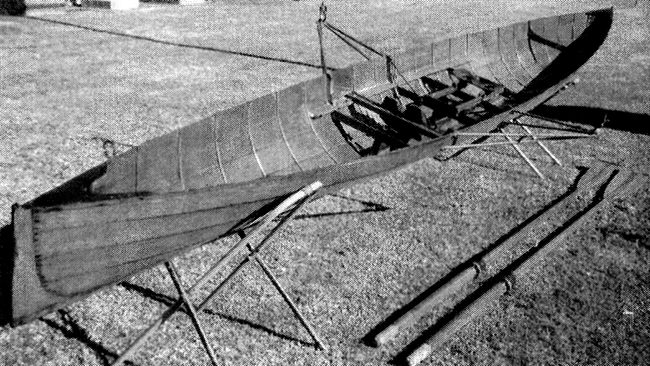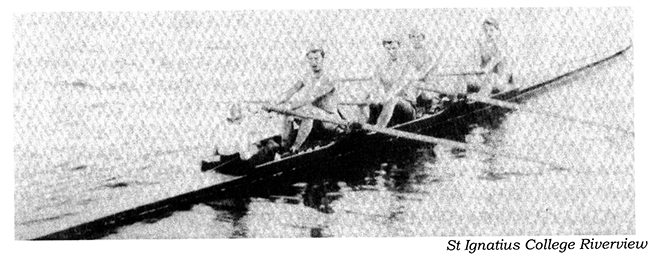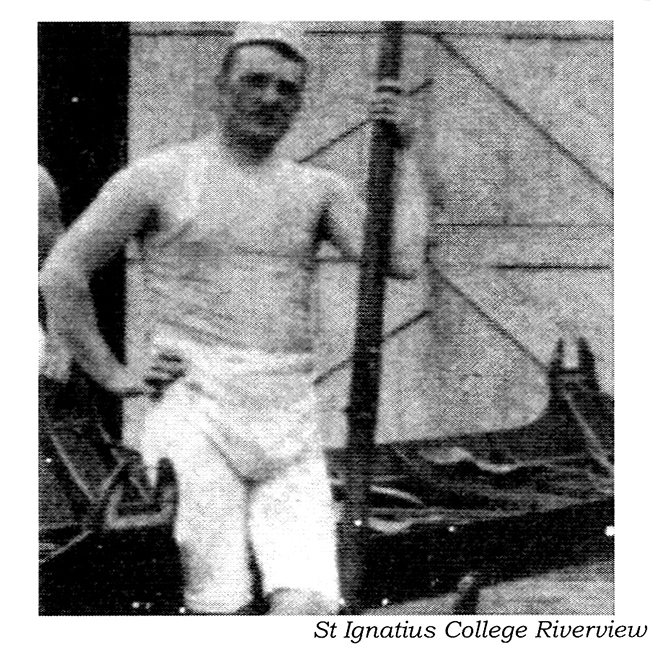History of Newcastle Rowing Club
Appendix A- Boats
"Boat" a hole in the 'Water lined with timber into which you throw money.
Anon.
Dinghy
Small, open clinker built light skiff with or without outriggers for one or two people cipsarried by a yacht or launch as a tender. They had a wide range of designs but typically were strong, had a squat appearance, sometimes flat bottomed and blunt ended. Being small their most common application at regattas in Australia was in single scull races for youths. Variable dimensions in all classes of boat meant that race organisers usually specified the maximum length allowed - measured either overall or at the keel. Dinghies used for competition in Newcastle over the years, ranged from less than 12' up to 19'.
Skiff
Originally, a skiff was as a ship's working boat used for small errands around the harbour. Some versions were used for recreational pursuits Slightly larger than a dinghy, a skiff was an open boat pulled by one or two pairs of sculls or two oars. Light watermens boats fitted within the skiff class. Approximately 22' long, 4'6" wide and 18" deep, they were an open boat capable of carrying 7 or 8 people. Being working boats, they were heavier and more strongly built than club skiffs but of similar dimensions. Costing about £22.10.0 each in 1870 they were an ideal size for most general purposes such as transporting passengers or goods around harbours and rivers. As they were in widespread use, sufficient numbers were readily available for racing. Commonly used for competition in Newcastle from the mid 1800s, their popularity ensured that they continued to be used until the 1930s despite being clinker built, inrigged and fitted with fixed seats. Skiffs were the forerunner of later single sculls, double sculls and pairs.
Over time, skiffs like other craft were modified for racing based on experience and technical improvements. Various skiff designs included:
a. Gladstone skiff. An improvement on earlier versions of the class. Construction details were:
- Open, double ended (pointed at both ends) single scull.
- Timber, clinker built.
- About 5.81 m long, 71 cm wide (amidships) 29 cm deep and span (pin to pin at the riggers), 1.53 m.
- Weight of early versions is unknown but was probably close to 75 lbs (34 kg), i.e., 20 kg heavier than the minimum weight for a single scull now.
- Fitted with a sliding seat and short outriggers.
Introduced in the 1890s, (of which NRC had several in 1893). They were a neat, stable and durable boat, ideal for general club use. Their popularity was such that they remained in use by clubs at least till the 1950s.

Gladstone skiff
b.Club skiff. Result of an agreement between SRC and MRC (c1876) to standardize boats used for racing. They were an open boat, 22' long, beam 4'6", depth 18" and weighed not less than 100 lbs.
c.Club skiff. Defined by NSWRA Rules of Racing (1899). A club skiff was an open boat with not more than 5 equal lap streaks on either side, be string test (see gigs), not exceed 22' long, nor be less than 1'4" deep and 4'6" beam and weigh not less than 130Ibs.
d.Club racing skiff (NSWRA 1899). An open boat not more than 22' long, beam not less than 4'6", weigh not less than 100 lbs and the swivel plate was not to project more than 1". Just prior to the adoption of this boat category (1896), a racing skiff with "all the latest improvements" built for George Towns was 22'6" long and weighed 26 lbs. Clearly this was not your average 'club' racing skiff. However, it not only demonstrates the extent to which weight could be minimised if desired but also highlights the variations that existed within various classes of boat.
Gig
Along with dinghies, skiffs and long boats (the largest), a gig was one of several types of boat usually carried by a sea-going ship. A gig was carried by many ocean-going vessels for use by the captain. They were a light, open, narrow boat, 24' - 32' long, clinker built with a keel, straight sheer (or sides) below the gunwales, upright stem and gunwale. They were inrigged, fitted with fixed seats and carried four or six oars, single banked. [one person to each oar]. In the early days of competitive rowing they were pulled by four oars or four pairs of sculls. Heavy watermens boats fitted within this category. Next generation gigs included: -
a.One Streak Racing Gig. 41' long, 2'7" wide. 18" slides.
b.String test gigs were regularly used in competition by rowing clubs as coxed fours from the 1870s, although they did not necessarily replace watermans boats in local regattas. Typical details were:
- 42' long and between 3'3" and 3'8" wide.
- Weighed between 145 and 180 pounds.
- Each end covered with canvas or in some cases calico or wood.
- To comply with the string test the boat had to be built so that a string passed from the gunwale on one side to the swivel pin or poppet on the other side touched all parts (or each plank) of the hull.
- Characteristics of the class were fixed timber poppet rowlocks extending above the gunwales and staggered seating. Such an arrangement allowed rowers the necessary distance from the rowlocks to maximise leverage.
- Early versions had fixed seats, later versions had sliding seats.
When formed in 1880, NRC acquired several string test gigs that would have cost £45 each if new. By January 1879 when they first appeared in Newcastle they were already old fashioned; probably because they were not fitted with outriggers. Even so, string test gigs remained in widespread use for many years. As late as 1890, NSWRA Regatta Rules allowed their use in four-oared races although best and best fours were a acceptable alternative for championship events. String test gigs continued to be acquired by Sydney clubs as late as 1894.

A string test gig. Note the staggered seating.

A close-up of the rowlock construction necessary to comply with the string test.
c. Regulation four (for Maiden Junior rowers) (NSWRA 1909). Length from bow to stern post, 35'. Slide, 22'. Thickness of skin 7/32". Length of outrigger solid iron, 2'6". Weight of boat including riggers and fittings not less than 145Ibs. To be carvel built, centre seated.
Regulation fours were used widely in competition by clubs in the early 1900s. They were slightly wider and shallower so more stable than best racing fours. The weight of Regulation four-oared boats used in competition by twenty-three NSWRA clubs in 1918 varied between 156 and 186 lbs.
Whaleboat. Approximately 30' long and 6' wide and pointed at both ends, whaleboats were were relatively light and strong. They carried a crew of six. The captain stood in the stern and handled the steering oar; the harpooner, when not otherwise engaged, pulled the bow oar and four crewmen rowed with oars that were balanced in length so that the boat could be rowed equally well by four or five. They were equipped with a mast and sail for times when conditions allowed.
Cutter. Heavily built rowing boat carried by sailing ships for work in fairly shallow water. They were about 34' long and 4'6" wide with fixed seats allowing six or eight rowers who sat two per seat, the pair pulling one oar [called double banked]. Before the age of steam, cutters were commonly used to follow races with the umpire in the passenger's position. Cutters had a reputation for performing better under sail than when rowed.
Lighter. Large, open, shallow drafted, usually flat-bottomed boat or barge. Used to carry goods and cargo relatively short distances between ships or between ships and shore. A misnomer if ever there was one, lighters were totally unsuitable for racing.
Clinker. (NSWRA 1906). A clinker pair, four or eight shall have not not less than four equal lap streaks, and top streak on either side, and must in no part be carve! built and the keel to show under the boat.
SINGLE SCULL, DOUBLE SCULL AND PAIR
During the advances in boat design and development, some of the terms used to describe a single scull included outrigger, outrigger skiff, clinker outrigger, wager boat, best boat or best and best boat.
Best (or best and best) boat. (As a general term meant without restriction). A best and best boat meant the best boat that a rower could procure for the purpose. Particularly used in Articles of Agreement applying to match races in wager boats.
Best boat (as specified by NSWRA, 1898). Best boats are the best of each particular class that can be made without regard to dimensions or streaks.
Wager boat. Initially, single scull used by professionals in racing when betting was involved. Much latitude was allowed in their construction. Over the years various lengths of boat were tried with some as short as 26' in fashion at times. By the early 1880s they had evolved into a top quality racing boat which could also be referred to as either a 'sculling outrigger' or, simply, 'outrigger'. By then they were approximately 30'-32' long, covered fore and aft, 11"-12" wide, 5 1/2" deep, 3 3/4" high forward, 2 5/8" aft, the slide was about 26" long and they weighed around 30 lbs. Naturally, dimensions varied according to the size and weight of the rower. Lighter and faster than a skiff they evolved to be virtually identical to a wooden version of a modern single scull. In the 1880s a first class wager boat with all the latest improvements cost £25 - £30.
Outrigger replaced skiffs in professional racing in the 1860s. When first introduced an outrigger was 30 - 34 foot long weighing 22 - 32 lbs with a fixed seat. Sliding seats followed in the 1870s.
Outrigger sculling skiff (1880). Usually built of cedar, 31'-32' long, about 10"- 12" wide, depth 51/i" with sliding seat on 26" long ivory rollers, ribs of outrigger of bent willow, weighing about 30 lbs. In the early 1880s, an outrigger could be bought for £20-£27, new and between £9-£19 second hand.
Single streak outrigger (1884). 30' 6" long, 10 1/2" beam, 5 1/4" amidships, 3 5/8" forward, 2 3/4" aft. Exceedingly light.
Stump outrigger. Developed in Australia in the 1890s. Shorter than the typical outrigger of the time they were 23' - 25' long, 11' beam, 6" deep amidships, 4 1/2" front and 3 1/2" aft. Preferred by some rowers who thought they were more buoyant and therefore faster than a normal outrigger. They didn't really catch on with professional scullers although George Towns enjoyed great success, and won the world championship, such a boat.
Clinker outrigger (1882). Single scull 30' long, 11" wide 5" deep and, with outriggers, weighed 48 lbs.
Outrigger. By the 1890s a typical racing scull was 31' long 10" beam, 6 1/2" amidships 3 1/2" forward and 2 3/4" aft.
Standard racing pair (NSWRA, 1897). Length not more than 27', beam excluding washboards not less than 2', depth amidships not less than 9", weight not less than 70 lbs. They were decked at both ends and outrigged.
Combined pair oar or double scull (NSWRA, 1909). Carvel built, canvassed fore and aft, centre seated, 31' long, 20" wide amidships, 8" deep amidships, skin 3/16" thick, 22" slide, with a minimum weight including riggers of 80 lbs.
Previous < The Modern Era
